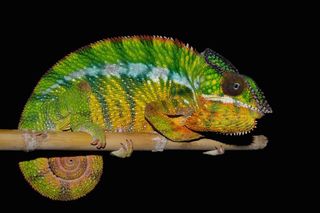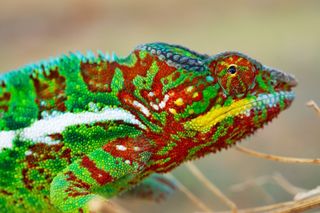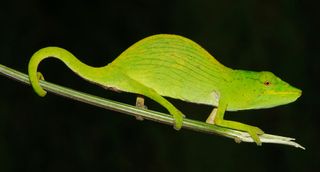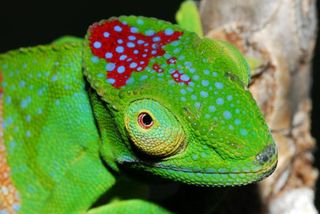Chameleon Facts

Chameleons are reptiles that are part of the iguana suborder. These colorful lizards are known as one of the few animals that can change skin color. However, it is a misconception that chameleons change colors to match their surroundings.
Size
According to the Integrated Taxonomic Information System (ITIS), there are 171 species of chameleons. With so many different species, there are many different sizes.

The largest chameleon is the Parson’s chameleon, according to Encyclopedia Britannica. It can grow up to 27 inches (69.5 centimeters) long. The Madagascan, also known as the Oustalet's chameleon, is also very large and grows up to 23 inches (60 cm) long.
The smallest chameleon has a special distinction. It is also one of the smallest vertebrates ever discovered. The leaf chameleon grows to just 0.5 inches (16 millimeters) and can sit comfortably on the head of a match.
Unlike other animals, chameleons continue to grow throughout their lives. As their old skin gets too small, they will shed it in bits and pieces, dissimilar to snakes that shed their skin all at once.

Skin of many colors
Changing skin color is an important part of communication among chameleons. According to the San Diego Zoo, a chameleon's skin changes colors in response to its emotions, such as anger or fear, changes in light, temperature or humidity.
The brighter the color, the more dominant the male is, and the more attractive he is to females. A submissive male is usually brown or gray. Females use their colors to accept or reject a suitor, and their color can also indicate that she is pregnant.
A new study has found that chameleons can rapidly change color by adjusting special cells, called iridophore cells, in each layer. The chameleons can change the structural arrangement of the upper cell layer by relaxing or exciting the skin, which leads to a change in color, researchers found. [Photos: How Chameleons Change Color]
Habitat
Chameleons live in Madagascar, Africa, Spain, Portugal and Asia in rain forests, savannas, semi-deserts and steppes, according to the San Diego Zoo. They typically stay in trees or bushes, though some species do live on the ground. For example, the horned leaf chameleon lives in dead leaves on forest floors according to the National Wildlife Federation. [Photos: 11 Colorful Chameleons of Madagascar]
Habits
Most chameleons have a prehensile tail that they use to wrap around tree branches. Their hands and feet have large toes that help them cling to branches.
Besides changing skin color, chameleons have another feature that no other animals have. Their eyes can move independently of each other, enabling them to look in two different directions at once. Chameleons have a full 360-degree view and can focus their eyes quickly and enlarge what they are looking at like a camera lens.
Chameleons are loners. In fact, most of the time females don't want males to even come near them. During the rare moments when the female is willing to be touched, the male will approach for mating. A brighter colored male chameleon is more likely to convince a female to mate than a duller colored male.
Diet
Chameleons eat insects and birds. To catch their prey, they creep along very slowly. Once the prey is in reach, their suction cup tongue shoots out and sticks to the insect. Their tongues can be as twice as long as their bodies when stretched out to catch prey, according to Encyclopedia Britannica. The insect is drawn back into the lizard's mouth to be digested by strong stomach acids.
Water is very important to chameleon growth and health. They either slurp water up using their tongues or the inhale it.

Offspring
Chameleons are different from many reptiles because some of the species, like the Jackson’s chameleon, have live births. These species can give birth to eight to 30 young at one time after a gestation of four to six months. While the young are born live instead of in an egg, they started as an egg. These mothers incubate the eggs, minus a shell, inside of her body instead of laying them in a nest.
Other chameleon species lay eggs that have an incubation period of four to 24 months, depending on species, according to the San Diego Zoo. The size of the chameleon predicts how many eggs she will lay. Small chameleon species lay two to four eggs while larger chameleons lay 80 to 100 eggs at one time.
No matter what species, chameleons become mature at 1 to 2 years of age. The exception is the Madagascan chameleon. It has been labeled as the vertebrate with the world's shortest life span, according to Encyclopedia Britannica. Their eggs hatch in November, the young become adults in January, they lay eggs in February, and then the entire adult population perishes after a lifespan of just three months.
Classification/taxonomy
The taxonomy of chameleons, according to the ITIS, is:
- Kingdom: Animalia
- Subkingdom: Bilateria
- Infrakingdom: Deuterostomia
- Phylum: Chordata
- Subphylum: Vertebrata
- Infraphylum: Gnathostomata
- Superclass: Tetrapoda
- Class: Reptilia
- Order: Squamata
- Suborder: Iguania
- Family: Chamaeleonidae
- Subfamilies: Brookesiinae, Chamaeleoninae
- Genera & species: Within the two subfamilies are nine genera and 171 species. A few examples — Calumma parsonii (Parson’s chameleon), Furcifer oustaleti (Oustalet's chameleon), Brookesia minima (pygmy leaf chameleon), Chameleo jacksonii (Jackson’s chameleon)
Conservation status

According to International Union for Conservation of Nature's Red List of Threatened Species, many species of chameleon are endangered. Some species that are considered in danger of extinction are the tiger chameleon, Elandsberg dwarf chameleon, Namoroka leaf chameleon and the Decary's leaf chameleon.
Additional resources
Sign up for the Live Science daily newsletter now
Get the world’s most fascinating discoveries delivered straight to your inbox.
